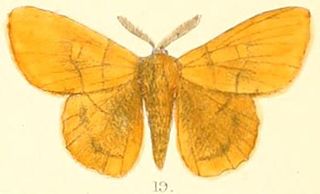
Lasiocampoidea is the superfamily of "lappet moths" (Lasiocampidae), containing one family of small to very large moths.

The Lasiocampidae are a family of moths also known as eggars, snout moths, or lappet moths. Over 2,000 species occur worldwide, and probably not all have been named or studied.

Eriogaster lanestris, commonly known as the small eggar, is a moth of the family Lasiocampidae that is found across the Palearctic. Unlike many other members of the Lasiocampidae, the small eggar is a social insect. Historically, only eusocial insects like ants, bees, and termites were thought to exhibit complex social organization and communication systems. However, research since the late 20th century has found that E. lanestris, among a number of other phylogenetically related moth and butterfly species, demonstrates social behaviors as well. Larvae spend nearly their entire development in colonies of about 200 individuals, and this grouped social structure offers a number of benefits, from thermoregulation to increased foraging success.

Lasiocampa quercus, the Oak Eggar, is a common moth of the family Lasiocampidae found in Europe, including Britain and Ireland. It feeds on a variety of plant species, and may develop over two years in higher latitudes, where it may be known as the Northern eggar. Its suffix quercus refers to the fact that its cocoon generally resembles an acorn.

Poecilocampa populi, the December moth, is a moth of the family Lasiocampidae.
Cerberolebeda is a monotypic moth genus in the family Lasiocampidae described by Vadim V. Zolotuhin in 1995. Its single species, Cerberolebeda styx, described by the same author in the same year, is found in eastern India, Myanmar, northern Thailand, northern Laos, northern Vietnam and Hainan, China.

Crinocraspeda is a monotypic moth genus in the family Lasiocampidae described by George Hampson in 1893. Its only species, Crinocraspeda torrida, was described by Moore in 1879.
Euthrix is a genus of moths in the family Lasiocampidae. The genus was erected by Johann Wilhelm Meigen in 1830. It includes the following species:

Lasiocampa is a genus of moths in the family Lasiocampidae. The genus was described by Franz von Paula Schrank in 1802.

Euxoa adumbrata, the sordid dart, is a moth of the family Noctuidae. The species was first described by Eduard Friedrich Eversmann in 1842. In North America it is found across northern Canada from Quebec to western Alaska, south to the northern parts of the United States, and in the mountains to Colorado. It is also found in Greenland, the coastal areas of Scandinavia and the Ural. It was recently recorded from Denmark, although this includes Euxoa lidia, which some authors regard to be a valid species.

Blepharita amica is a moth of the family Noctuidae. It is found from northern Europe to the Russian plain, the Ural, Siberia, the Amur Oblast, Primorye Region and Kazakhstan. It has also been recorded from the Korean Peninsula, Japan and north-eastern China.

Phyllodesma americana, the American lappet moth, is a moth of the family Lasiocampidae. It is found from Nova Scotia to Georgia, west through Texas to California, north to British Columbia and Yukon.

Trichiura crataegi, the pale eggar or pale oak eggar, is a moth of the family Lasiocampidae. It was first described by Carl Linnaeus in his 1758 10th edition of Systema Naturae. It is found in all of Europe, east to Anatolia.

Gastropacha sikkima is a moth in the family Lasiocampidae. It is found in India, northern Thailand, Laos and Taiwan.

Paralebeda femorata is a moth of the family Lasiocampidae. It is found from the Russian Far East, eastern Mongolia, Korea and north-eastern China over eastern and central China and Taiwan to Bhutan, Nepal, northern India, Pakistan and northern Vietnam.












